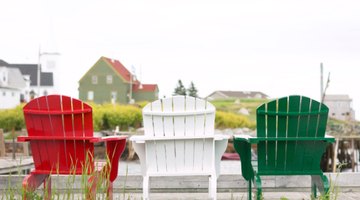Paint Tips for Rustoleum
Table of Contents
Painting with Rustoleum isn’t any harder than painting with most other paints. Rustoleum is designed to save your precious items from rust by giving it a hard coat finish that will last for years. The company has put a lot of work into its formulas to make it easier as long as you follow a few simple steps.

Paint Type
Just because it’s Rustoleum does not mean it’s the right one for the job. Choose the right Rustoleum for your project. Different surfaces have different properties that require different adhesives in the paint. Choosing the wrong type of Rustoleum will mean the paint could peel. Rustoleum is compatible with metal and stone, and even offers high-temperature paints for barbecues. If you're not sure what type of Rustoleum you need, you can get help from your local expert at the paint store.
Preparation
Before you protect your treasure with Rustoleum, make sure the surface is clean and smooth. Rustoleum's preparation guide recommends removing dirt, grease, oil and chemicals as well as any chipping paint or loose rust. Sanding or simply washing with paint thinners or soapy water is the best way to prepare the surface. Make sure the item you want to paint is dry. Once it's clean, prime the item with Rustoleum primer.
Right Time and Place
Read the instructions on the can of paint. Rustoleum paint needs the right amount of heat and humidity for it to dry properly. Spraying Rustoleum should be done in a well-ventilated place where you won’t mind a little overspray. Avoid spraying Rustoleum in direct sunlight, which will fade the color as it dries. Starting early in the day will give you plenty of time to finish the job without rushing.
Spray Technique
Spray Rustoleum in thin coats, never a thick coat, and allow proper dry times. Never start or stop spraying on the item. Start spraying just past the edge of the item and spray across the item in a steady, even stroke going past the other edge before stopping. Hold the can the correct distance from the item. Practice spraying the Rustoleum on a sheet of newspaper to get the feel of it before you start. Set a timer for when the next coat should be applied.
Drying It
Leave it alone. Let it dry on its own. Touching tacky Rustoleum with your fingers will leave prints that show up when dry. Don’t let it dry under sunlight. Sunlight can destroy Rustoleum's protective properties while drying. Don’t stir up dust in the room as that can settle on the paint and become stuck to it. The longer you leave it alone after you are finished painting the longer your item will last.
The Drip Cap
- Painting with Rustoleum isn’t any harder than painting with most other paints.
- Rustoleum is compatible with metal and stone, and even offers high-temperature paints for barbecues.
- Hold the can the correct distance from the item.
- Practice spraying the Rustoleum on a sheet of newspaper to get the feel of it before you start.
- Set a timer for when the next coat should be applied.
- Touching tacky Rustoleum with your fingers will leave prints that show up when dry.
- The longer you leave it alone after you are finished painting the longer your item will last.
References
Resources
Writer Bio
Based in Toronto, Canada, Andrew Copley has been contributing online articles on alternative treatments for immune disorders since 2008. After six years continuing research, Copley has acquired extensive knowledge on nutrition and its effects on the immune and nervous system. He holds a level one standing in university physics and science from Fanshaw College.
Photo Credits
- Dynamic Graphics Group/Dynamic Graphics Group/Getty Images
- Dynamic Graphics Group/Dynamic Graphics Group/Getty Images
More Articles



